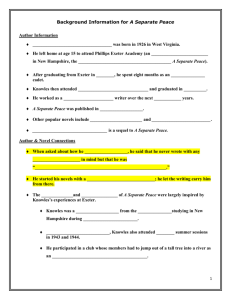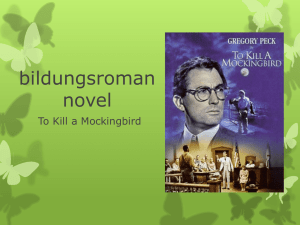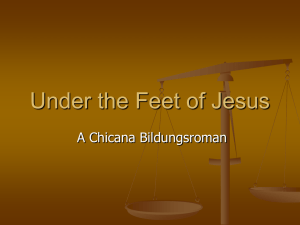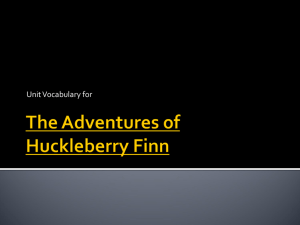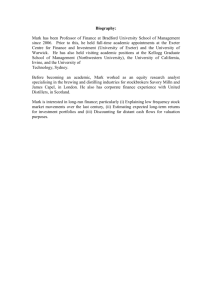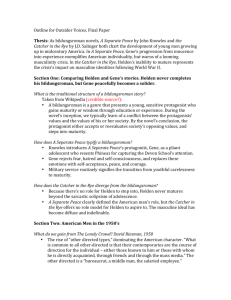A Separate Peace
advertisement
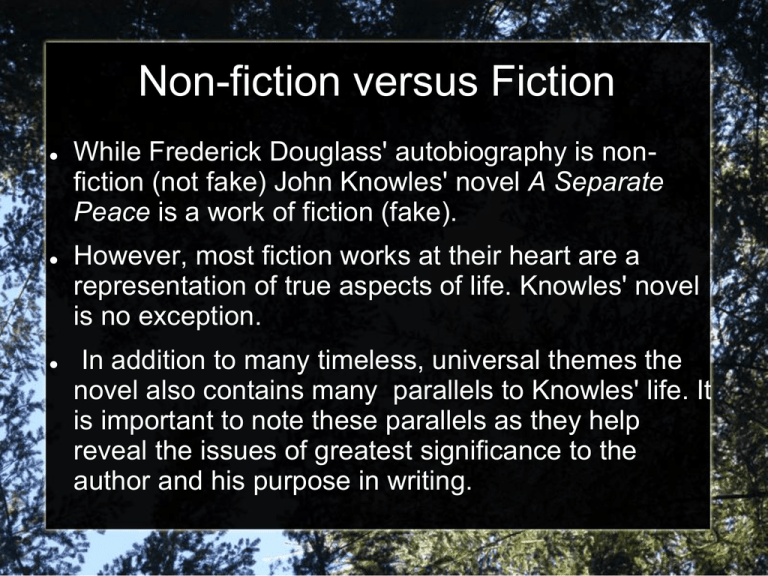
Non-fiction versus Fiction While Frederick Douglass' autobiography is nonfiction (not fake) John Knowles' novel A Separate Peace is a work of fiction (fake). However, most fiction works at their heart are a representation of true aspects of life. Knowles' novel is no exception. In addition to many timeless, universal themes the novel also contains many parallels to Knowles' life. It is important to note these parallels as they help reveal the issues of greatest significance to the author and his purpose in writing. JOHN KNOWLES Born in 1926 in Fairmont, West Virginia At 15 he enrolled in Phillips Exeter Academy, a well-known boarding school in New Hampshire that shares many similarities with the fiction school Devon he creates in A Separate Peace He graduated from Exeter in 1945 and joined the war effort as part of the U.S. Army Air Force's Aviation Cadet Program After eight months in the program, he became a student at Yale University. He graduated from Yale in 1949. John Knowles con... After graduation, he travelled to Europe and worked as a journalist. He also sold short-stories. In 1957 he returned to the US and took a job as an associate editor with Holiday magazine. Thornton Wilder, author of the play Our Town, encouraged Knowles to write a novel. The result was Knowles first and most successful work, A Separate Peace. Success as a novelist enabled him to quit the magazine and pursue writing full-time. He published eight other books, a travel book, and a collection of short stories. As in his first work, his main themes are greed, competitiveness, and corruption in the lives of wealthy American characters. He died on November 29th, 2001 at the age of 75. Knowles at Exeter Academy Member of a secret society Sustaining a foot injury while jumping from a tree during society exercises In his essay, "A Special Time, A Special Place," Knowles wrote: “The only elements in A Separate Peace which were not in that summer were anger, violence, and hatred. There was only friendship, athleticism, and loyalty.” A student named Phineas Sprague lived in the same dorm and Phineas (Finny) the character was based on David Hackett, a friend Knowles met during a summer session at Exeter. Brinker was also based on a Exeter student, Gore Vidal. Exeter Academy Founded in 1781, Exeter continues to hold a prestigious reputation Tuition is $46,900/yr but families who make less than $75,000/yr can apply for financial aid Average class size is 12 and is conducted according to the Harkness educational method Today there is a diverse student body of just over 1,000 students, but in Knowles time it would have been about 500 and consisted solely of boys Non Sibi (Not for Oneself) Finis Origine Pendet (The End Depends Upon the Beginning) Χάριτι Θεοῦ (By the Grace of God) Exeter Academy The Economist has described the school as belonging to "an elite tier of private schools" in Britain and America that counts Eton and Harrow in its ranks. The school's facilities had been described "as luxurious as the nation's top universities" by The New York Times. Phillips Exeter Academy had an acceptance rate of 19% for the 2013 school year. A movie based on the novel was filmed on campus in 1972 World War II WW II was a “total war” meaning that the war effort extended beyond soldiers fighting abroad and deeply affected the lives of civilians. Indeed, WWII is the deadliest conflict to have ever occurred and cost the most civilian lives. While this was primarily the result of the genocide of European Jews, it was also the result of the Luftwaffe's bombings on London, the atomic bombings of Hiroshima and Nagasaki, and the famine that broke out in many areas across Europe and Russia. Civilians in the US became involved in WWII through recycling, or “salvages,” of rubber, tin, metal, paper; rationing of gas, rubber, sugar, etc...; food drives and “victory gardens” World War II con... WW II also changed the home-front and the American workplace/economy forever as it introduced women to the workforce in record numbers and atypical positions It also taught Americans the value of saving ~ especially through war bonds and saving bonds **Connection to F. Douglass** WWII also proved to be a dramatic impetus to the civil rights movement as soldiers confronted the injustice of limiting the rights of the men risking death beside them and civilians reacted to the discrimination of the Nazis against the Jews by striving to overcome their own prejudices. For many black Americans WWII became a “Double V Campaign” against fascism abroad and discrimination at home. Universal Themes There is a reason why certain novels become classics. Literature is an encapsulation of life. Indeed, Former President John F. Kennedy stated, "I see little of more importance to the future of our country and of civilization than full recognition of the place of the artist. If art is to nourish the roots of our culture, society must set the artist free to follow his/her vision wherever it takes him/her." Beverly Sills extended his observation insisting, "Art is the signature of civilization.“ The truly great works that frequently become classics embody both the period in which they were written and all times. Consider the blurbs on the front and back of the novel, as well as your knowledge of the text itself, to compose a list of universal themes. UNIVERSAL THEMES Bildungsroman (coming of age – psychological and moral growth; therefore character change is important) Jealousy Loss of innocence Coping with loss/ death Guilt Fear Competitiveness Loyalty Bildungsroman In literary criticism, the German term Bildungsroman refers to a novel of formation, novel of education, or coming-of-age story. Such works focus on the psychological and moral growth of the protagonist from youth to adulthood (coming of age), and thus character change is extremely important. A Bildungsroman relates the growing up or "coming of age" of a sensitive person who goes in search of answers to life's questions with the expectation that these will result from gaining experience of the world. Bildungsroman con... The genre evolved from folklore tales of a dunce or youngest son going out in the world to seek his fortune. Usually, in the beginning of the story there is an emotional loss which makes the protagonist leave on his journey. In a Bildungsroman, the goal is maturity, and the protagonist achieves it gradually and with difficulty. The genre often features a main conflict between the main character and society. Typically, the values of society are gradually accepted by the protagonist and he/she is ultimately accepted into society — the protagonist's mistakes and disappointments are over. In some works, the protagonist is able to reach out and help others after having achieved maturity. What examples can you think of? Bildungsroman examples Jane Eyre, by Charlotte Brontë (1847); Great Expectations, by Charles Dickens (1861); The Adventures of Huckleberry Finn, by Mark Twain (1884) Black Boy, by Richard Wright (1945); The Catcher in the Rye, by J.D. Salinger (1951) The Voyage of the Dawn Treader (for plot character Eustace Scrubb) by C. S. Lewis (1952) To Kill a Mockingbird, by Harper Lee (1960) Dune, by Frank Herbert (1965); A Wizard of Earthsea, by Ursula K. Le Guin (1968); Ender's Game, by Orson Scott Card (1985) The Outsiders, by S. E. Hinton (1967); The Perks of Being a Wallflower, by Stephen Chbosky (1999) Persepolis, by Marjane Satrapi (2000); The Secret Life of Bees, by Sue Monk Kidd (2002); The Kite Runner, by Khaled Hosseini (2003) Paragraph response Explain which characters in A Separate Peace fit the definition of a Bildungsroman and how they do so. Literary Devices Simile: “I felt fear's echo, and along with that I felt unhinged, uncontrollable joy which had been its accompaniment and opposite face, joy which had broken sometimes in those days like Northern Lights across black sky. This quote is significant for more than its use of a simile. The imagery involved also connects to the theme of fear and makes the larger point that sometime in the fifteen years since Gene has been a student at Devon he has somehow managed to escape the fear that has haunted him. This fact implies that he has gained a new perspective on the instances of his youth and has grown up (Bildungsroman). Furthermore, it re-emphasizes just how much of his previous life has been dominated by fear if joy “had broken sometimes” rather than frequently across a black sky. The simile itself reinforces the majestic and unusual nature of joy in those days and how fleeting its appearance. Lit Devices con... Oxymoron: a pair of words that are opposites, used together. According to Gene, “Devon is sometimes considered the most beautiful school in New England...” (12). However, its beauty is complicated both by the events that occur at the school and by its very architecture. Gene notes that the school's beauty exists “in small areas of order—a large yard, a group of trees, three similar dormitories, a circle of old houses—living together in contentious harmony” (12). Attending to the author's use of such devices is important not only because it adds to the richness of the story but because the author's word choice reinforces key themes and contains implicit messages for the canny reader. Here, Knowles alludes to the fact that despite the sometimes idyllic portrait of student life he depicts that there is a struggle beneath the surface that is reflected in Devon itself. Indeed, Devon is a symbol of Gene's childhood and particularly of his loss of innocence. What else does Devon seem to symbolize? Discuss. Lit Devices con... Symbols are images, ideas, sounds or words that represent something else and help to understand an idea or a thing. Motifs, on the other hand, are images, ideas, sounds or words that help to explain the central idea of a literary work i.e. theme. Moreover, a symbol may appear once or twice in a literary work, whereas a motif is a recurring element. For example: the tree in the story is a symbol of crisis which connects to the motifs of change and violence which connect to the themes of bildungsroman and loss of innocence. “Unbelievable that there were other trees which looked like it here. It had loomed in my memory as a huge lone spike dominating the riverbank, forbidding as an artillery piece, high as the beanstalk. Yet here was a scatter grove of trees, none of them of any particular grandeur” (13). Notice the similes used in the line above. What do they add? How would you classify the war? Explain. Lit. Devices con... Foreshadowing “So the more things remain the same, the more they change after all — plus c'est la même chose, plus ça change. Nothing endures, not a tree, not love, not even death by violence” (14). This quote foreshadows the fact that the coming tale will contain not only change but loss, specifically of love and life. It also alludes to the fact that violence will be a prevalent part of the tale. Catching these subtle hints early help make the references to war even more prominent. The line is also a paradox: a phrase that contradicts itself if elaborated to its logical conclusion or that contains a contradict that is nonetheless true in some manner. Flashback Chapter One Establishes first-person narrative voice (Gene), main characters, and the setting. Due to the use of flashback there are two times (1957, 1942) to the tale though the action in both times is primarily confined to Devon School in New Hampshire. Phineas' role as a leader is established, as well as his close friendship with Gene. Jumping from the tree as a writ of passage and superiority is described. The liminal nature of the boys' lives that Summer Session is delineated. Key Lines As you read the works in our curriculum this year, you will need to keep a constant eye out for lines that connect to key themes and philosophical ideas that could be used in a paper. The best lines will be those that you can discuss on many levels by connecting to themes, character development, author's purpose, stylistic effects, etc.... We've already looked at a few key lines already but here are a few more. Pg 15, btm paragraph: The existence of the Summer Session is due entirely to the war. Thus, while the school insulates the boys in some ways in others the changes at the school reinforce how deeply the war is effecting the country. Furthermore, here the importance of the tree is established as a coming of age ritual and as an introduction to the danger and violence of the war. The descriptions on the following page of Gene's first jump reinforce this connection. Finally, the boys' current innocence is established by the fact they “were still calmly, numbly reading Virgil and playing tag in the river farther downstream” (15).
